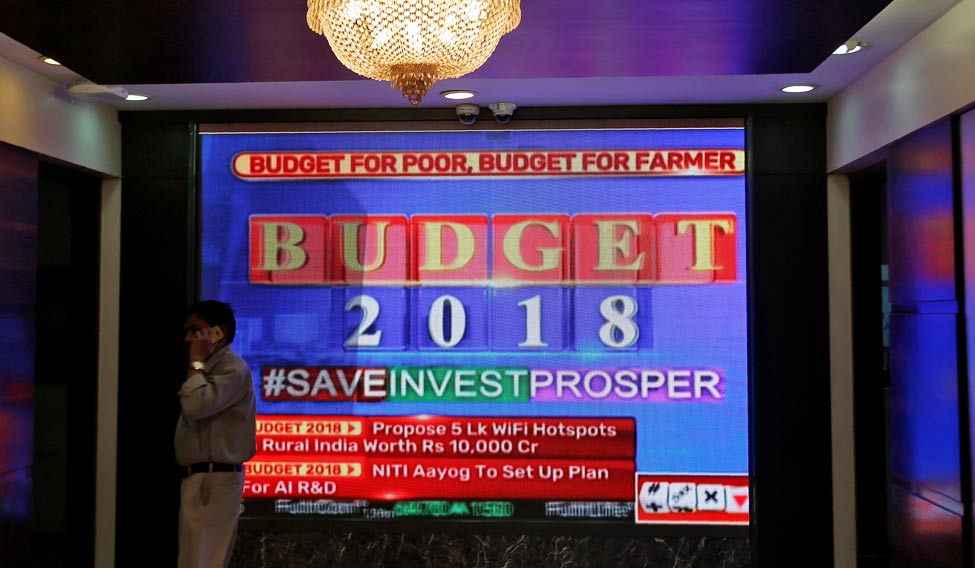India's benchmark 10-year bond yields hit a new 22-month high early on Friday and equity markets slipped further into the red as a higher fiscal deficit and bringing back long-term capital gains tax has investors worried.
Finance Minister Arun Jaitley's budget proposal to hike minimum support prices for agriculture produce is also raising inflationary fears, which could further harden RBI's stand on maintaining or even raising interest rates over the next few quarters, which is also dampening sentiments.
On Thursday, India's bond yields had closed at 7.60 per cent up near 18 basis points from previous close and on Friday further rose to 7.66 per cent.
Equities were also under further pressure, with the BSE Sensex down 496 points or 1.38 per cent at 35,410.07 points in morning trade. The NSE Nifty 50 also slipped 150 points or 1.4 per cent to 10,867 points.
“The bond market is reflecting some unease around the revenue and spending targets and the proposal of increasing the MSP of all crops to at least 1.5 times that of the production cost likely stoking inflation,” said Sunil Sharma, chief investment officer at Sanctum Wealth Management.
The worry among investors is the fiscal slippage in 2017-18, which ratings agency CRISIL pointed out was despite a near 12 per cent cut in capital expenditure relative to what was budgeted.
“The government has for the second consecutive year already breached its fiscal deficit to gross domestic product (GDP) target of three per cent. As opposed to a budgeted 3.2 per cent, fiscal deficit in fiscal 2018 stood at 3.5 per cent and is budgeted at 3.3 per cent in fiscal 2019. But the more worrisome part is that the breach in fiscal deficit is despite a cut in capex, that means, had the government stuck to its targeted capital expenditure for fiscal 2018, fiscal deficit would have been still higher. Moreover, it is the productive spending in the economy that has seen a compromise, making way for revenue spending,” said CRISIL.
Furthermore, the government’s fiscal consolidation path has got stretched by three years and instead of achieving a 3 per cent fiscal deficit in fiscal 2018, the government now hopes to achieve the same in fiscal 2021, CRISIL added.
On the equity side, apart from the tax on long-term capital gains of over Rs 1 lakh on equities, to bring in parity, Jaitley in the budget also proposed a 10 per cent tax on dividend distribution by mutual funds, which some analysts hope will hurt the robust inflows that equity mutual funds have received over the last 12-15 months.
“Flows to mutual funds' income schemes may see a slowdown with dividend distribution tax being introduced,” said Gopikrishna Shenoy, chief investment officer at SBI Life Insurance.
The decision to deduct 10 per cent tax on equity fund dividends is also unfair as it amounts to double taxation for equity fund investors, added Mayuresh Joshi, fund manager at Angel Broking.
Brokerages are cautious on Indian markets post the budget and expect a correction from the already high valuations.
Bank of America Merrill Lynch, for instance, expects the Sensex to fall to 32,000 by the end of December 2018.
All eyes will now shift to the Reserve Bank of India's bi-monthly monetary policy announcement. The central bank is largely expected to maintain key interest rates on hold through 2018, but there is a growing worry that interest rates could head upwards.
“There is a constellation of stars coming together today that points towards a much higher level of interest rates in the months to come, more than simply some slippages in fiscal numbers,” said Somnath Mukherjee, managing partner, ASK Wealth Advisors.
There are several reasons—the economy is expected to grow faster next fiscal, sharp uptick in global crude oil prices, the proposal of higher MSPs, and globally interest rates are expected to rise in line with coordinated growth recovery around the world.
“Putting all the above three together, there is only one conceivable place interest rates can go, and that is north,” added Mukherjee.






